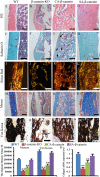An appropriate Wnt/β-catenin expression level during the remodeling phase is required for improved bone fracture healing in mice
- PMID: 28578392
- PMCID: PMC5457421
- DOI: 10.1038/s41598-017-02705-0
An appropriate Wnt/β-catenin expression level during the remodeling phase is required for improved bone fracture healing in mice
Abstract
Accumulating evidence demonstrates that the Wnt/β-catenin signaling pathway plays a dominant role in bone repair. However, the role of Wnt/β-catenin signaling in the remodeling phase during bone fracture healing is currently unknown. In the present study, β-catenin was activated at different levels or deleted in mice at the late stage of fracture healing, and the effects on healing quality were investigated. Deletion of β-catenin disturbed bone remodeling, as confirmed by increased bone resorption and decreased bone formation, and significantly decreased bone strength compared with wildtype mice. In addition, the constitutive activation of β-catenin significantly increased the bone mass and delayed the bone remodeling process, resulting in slightly impaired bone strength. In contrast, a slight activation of β-catenin significantly increased bone formation and slightly hindered bone resorption. These effects lead to improved bone fracture healing quality compared with wildtype mice. In summary, the present study provides the first demonstration showing that Wnt/β-catenin signaling should be maintained at a slightly activated level during the late stage of fracture healing to ensure better bone fracture repair.
Conflict of interest statement
The authors declare that they have no competing interests.
Figures





References
-
- Komatsu DE, Warden SJ. The control of fracture healing and its therapeutic targeting: improving upon nature. Journal of cellular biochemistry. 2010;109:302–311. - PubMed
Publication types
MeSH terms
Substances
LinkOut - more resources
Full Text Sources
Other Literature Sources

